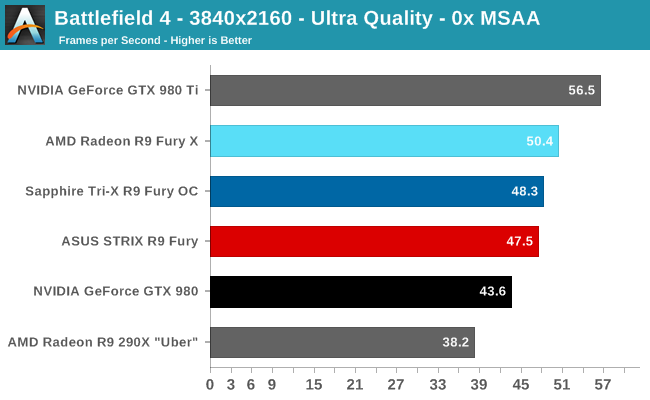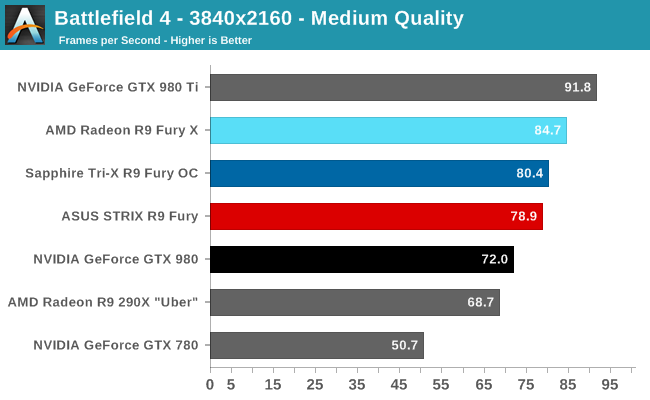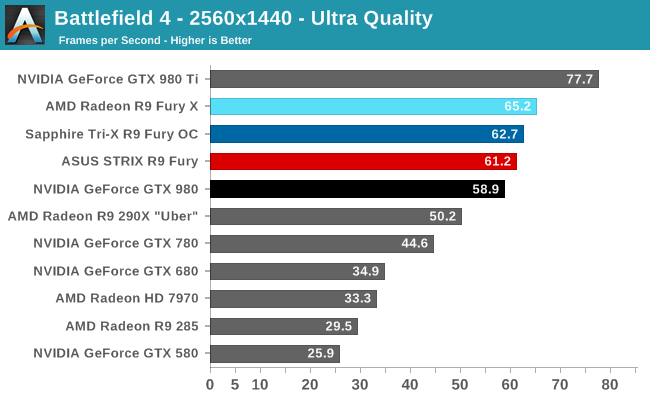The AMD Radeon R9 Fury Review, Feat. Sapphire & ASUS
by Ryan Smith on July 10, 2015 9:00 AM ESTBattlefield 4
Kicking off our benchmark suite is Battlefield 4, DICE’s 2013 multiplayer military shooter. After a rocky start, Battlefield 4 has since become a challenging game in its own right and a showcase title for low-level graphics APIs. As these benchmarks are from single player mode, based on our experiences our rule of thumb here is that multiplayer framerates will dip to half our single player framerates, which means a card needs to be able to average at least 60fps if it’s to be able to hold up in multiplayer.



When the R9 Fury X launched, one of the games it struggled with was Battlefield 4, where the GTX 980 Ti took a clear lead. However for the launch of the R9 Fury, things are much more in AMD’s favor. The two R9 Fury cards have a lead just shy of 10% over the GTX 980, roughly in-line with their price tag difference. As a result of that difference AMD needs to win in more or less every game by 10% to justify the R9 Fury’s higher price, and we’re starting things off exactly where AMD needs to be for price/performance parity.
Looking at the absolute numbers, we’re going to see AMD promote the R9 Fury as a 4K card, but even with Battlefield 4 I feel this is a good example of why it’s better suited for high quality 1440p gaming. The only way the R9 Fury can maintain an average framerate over 50fps (and thereby reasonable minimums) with a 4K resolution is to drop to a lower quality setting. Otherwise at just over 60fps, it’s in great shape for a 1440p card.
As for the R9 Fury X comparison, it’s interesting how close the R9 Fury gets. The cut-down card is never more than 7% behind the R9 Fury X. Make no mistake, the R9 Fury X is meaningfully faster, but scenarios such as these question whether it’s worth the extra $100.










288 Comments
View All Comments
bill.rookard - Friday, July 10, 2015 - link
Impressive results, especially by the Sapphire card. The thing I'm glad to see is that it's such a -quiet- card overall. That bodes well for some of the next releases (I'm dying to see the results of the Nano) and bodes well for AMD overall.Two things I'd like to see:
1) HBM on APU. Even if it were only 1GB or 2GB with an appropriate interface (imaging keeping the 4096 bit interface and either dual or quad-pumping the bus?). The close location of being on-die and high speed of the DRAM would be a very, VERY interesting graphics solution.
2) One would expect that with the cut down on resources, there would have been more of a loss in performance. On average, you see a 7-8% drop in speed after a loss of 13-14% cut in hardware resources and a slight drop in clock speeds. So - where does that mean the bottleneck in the card is? It's possible that something is a bit lopsided internally (it does however perform exceptionally well), so it would be very interesting to tease out the differences to see whats going on inside the card.
mr_tawan - Friday, July 10, 2015 - link
It would be very interesting to run HBM as the system ram instead of DDR on APU. 4GB (for the 1) wouldn't be a lot and may choke on heavy work load, but for casual user (and tablet uses) that's probably enough.It would also allow smaller machine than NUC form factor, I think.
looncraz - Friday, July 10, 2015 - link
HBM wouldn't be terribly well suited for system RAM due to its comparatively low small-read performance and physical form factor. On an APU, for example, it would probably be best used as a single HBM[2] chip on a 1024-bit bus. Probably just 1 or 2GB, largely dedicated to graphics. That is 128GB/s with HBM1 (but 1GB max), 256GB/s with HBM2 (with, IIRC, 4GB max).For a SoC, though, such as the NUC form factor, as you mentioned, it is potentially a game changer only AMD can deliver on x86. Problem is that the net profit margins in that category are quite small, and AMD needs to be chasing higher net margin markets (net margin being a simple result of market volume, share, and product margin).
I'd love to see it, though, for laptops. And with Apple and AMD being friendly, we may end up seeing it. As well as probably seeing it find its way into the next generation of consoles.
Oxford Guy - Saturday, July 11, 2015 - link
Given the high prices Intel is charging for its NUC systems are you really certain it's not profitable? Perhaps sales aren't good because they're overpriced.Stuka87 - Friday, July 10, 2015 - link
The only way to keep the 4096bit bus would be to use four HBM chips, and I highly doubt this would be the case. I am thinking an APU would use either a single HBM chip, or possibly two. The performance boost would still be huge.ajlueke - Friday, July 10, 2015 - link
1) I can't imagine we won't see this. APU scaling with RAM speed was pretty well documented, I would be surprised if there were socket AM4 motherboards that incorporated some amount of HBM directly. Also, AMD performs best against NVidia at 4K, suggesting that Maxwell may be running into a memory bandwidth bottleneck itself. It will be interesting to see how Pascal performs when you couple a die-shrink with the AMD developed HBM2.2) It does suggest that Fiji derives far more benefit from faster clocks versus more resources. That makes the locked down voltages for the Fury X even more glaring. You supply a card that is massively overpowered, with 500W of heat dissipation but no way to increase voltages to really push the clock speed? I hope we get custom BIOS for that card soon.
silverblue - Saturday, July 11, 2015 - link
As regards APU scaling, it's a tough one. More bandwidth is good, however scaling drops above 2133MHz which shows you'd need more hardware to consume it. Would you put in more shaders, or ROPs? I'd go for the latter - don't APUs usually top out at 8 ROPs? Sure, add in more bandwidth, but at the very least, increase how much the APU can actually draw. The HD 4850 had 32 TMUs (like the 7850K) but 16 ROPs, which is double that on offer here.I keep seeing complaints about AMD's ROP count, so perhaps there's some merit to them.
Nagorak - Sunday, July 12, 2015 - link
It's hard to say what the bottleneck is with memory scaling on APUs. It could be something related to the memory controller built into the CPU rather than the GPU not having the resources to benefit.silverblue - Monday, July 13, 2015 - link
Isn't there a 256-bit Radeon Memory Bus link between memory and the GPU? Just a question.Stuka87 - Friday, July 10, 2015 - link
Is it just me, or is the 290X faster now than it used to be when compared to the 980? Perhaps the 15.7 drivers offered some more performance?